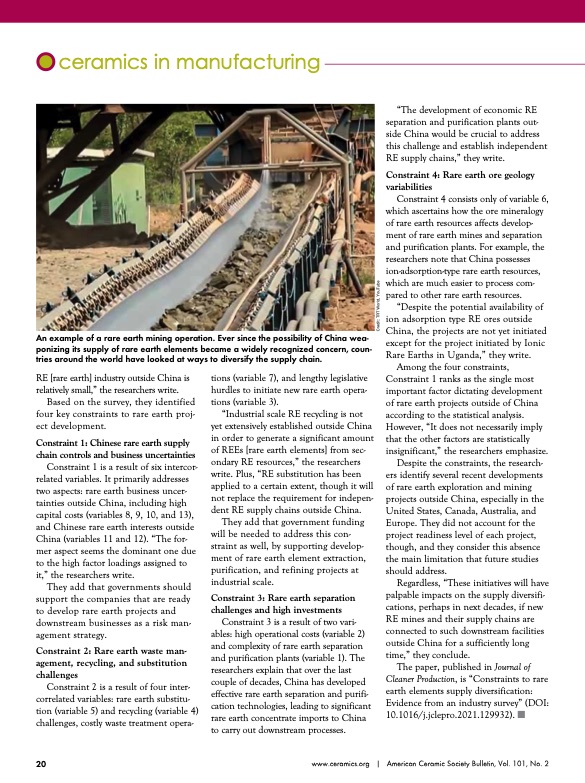
PDF Publication Title:
Text from PDF Page: 022
ceramics in manufacturing An example of a rare earth mining operation. Ever since the possibility of China wea- ponizing its supply of rare earth elements became a widely recognized concern, coun- tries around the world have looked at ways to diversify the supply chain. “The development of economic RE separation and purification plants out- side China would be crucial to address this challenge and establish independent RE supply chains,” they write. Constraint 4: Rare earth ore geology variabilities Constraint 4 consists only of variable 6, which ascertains how the ore mineralogy of rare earth resources affects develop- ment of rare earth mines and separation and purification plants. For example, the researchers note that China possesses ion-adsorption-type rare earth resources, which are much easier to process com- pared to other rare earth resources. “Despite the potential availability of ion adsorption type RE ores outside China, the projects are not yet initiated except for the project initiated by Ionic Rare Earths in Uganda,” they write. Among the four constraints, Constraint 1 ranks as the single most important factor dictating development of rare earth projects outside of China according to the statistical analysis. However, “It does not necessarily imply that the other factors are statistically insignificant,” the researchers emphasize. Despite the constraints, the research- ers identify several recent developments of rare earth exploration and mining projects outside China, especially in the United States, Canada, Australia, and Europe. They did not account for the project readiness level of each project, though, and they consider this absence the main limitation that future studies should address. Regardless, “These initiatives will have palpable impacts on the supply diversifi- cations, perhaps in next decades, if new RE mines and their supply chains are connected to such downstream facilities outside China for a sufficiently long time,” they conclude. The paper, published in Journal of Cleaner Production, is “Constraints to rare earth elements supply diversification: Evidence from an industry survey” (DOI: 10.1016/j.jclepro.2021.129932). n RE [rare earth] industry outside China is relatively small,” the researchers write. Based on the survey, they identified four key constraints to rare earth proj- ect development. Constraint 1: Chinese rare earth supply chain controls and business uncertainties Constraint 1 is a result of six intercor- related variables. It primarily addresses two aspects: rare earth business uncer- tainties outside China, including high capital costs (variables 8, 9, 10, and 13), and Chinese rare earth interests outside China (variables 11 and 12). “The for- mer aspect seems the dominant one due to the high factor loadings assigned to it,” the researchers write. They add that governments should support the companies that are ready to develop rare earth projects and downstream businesses as a risk man- agement strategy. Constraint 2: Rare earth waste man- agement, recycling, and substitution challenges Constraint 2 is a result of four inter- correlated variables: rare earth substitu- tion (variable 5) and recycling (variable 4) challenges, costly waste treatment opera- tions (variable 7), and lengthy legislative hurdles to initiate new rare earth opera- tions (variable 3). “Industrial scale RE recycling is not yet extensively established outside China in order to generate a significant amount of REEs [rare earth elements] from sec- ondary RE resources,” the researchers write. Plus, “RE substitution has been applied to a certain extent, though it will not replace the requirement for indepen- dent RE supply chains outside China. They add that government funding will be needed to address this con- straint as well, by supporting develop- ment of rare earth element extraction, purification, and refining projects at industrial scale. Constraint 3: Rare earth separation challenges and high investments Constraint 3 is a result of two vari- ables: high operational costs (variable 2) and complexity of rare earth separation and purification plants (variable 1). The researchers explain that over the last couple of decades, China has developed effective rare earth separation and purifi- cation technologies, leading to significant rare earth concentrate imports to China to carry out downstream processes. 20 www.ceramics.org | American Ceramic Society Bulletin, Vol. 101, No. 2 Credit: TRT World, YouTubePDF Image | hydrogen as an alternative fuel

PDF Search Title:
hydrogen as an alternative fuelOriginal File Name Searched:
March2022.pdfDIY PDF Search: Google It | Yahoo | Bing
CO2 Organic Rankine Cycle Experimenter Platform The supercritical CO2 phase change system is both a heat pump and organic rankine cycle which can be used for those purposes and as a supercritical extractor for advanced subcritical and supercritical extraction technology. Uses include producing nanoparticles, precious metal CO2 extraction, lithium battery recycling, and other applications... More Info
Heat Pumps CO2 ORC Heat Pump System Platform More Info
| CONTACT TEL: 608-238-6001 Email: greg@infinityturbine.com | RSS | AMP |